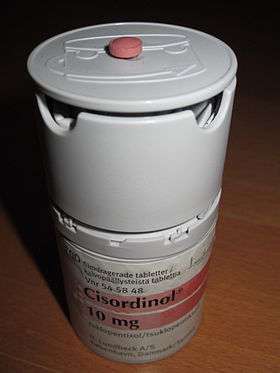Zuclopenthixol
 | |
| Clinical data | |
|---|---|
| Trade names | Clopixol |
| AHFS/Drugs.com | International Drug Names |
| Pregnancy category |
|
| Routes of administration | Oral, IM |
| ATC code | N05AF05 (WHO) |
| Legal status | |
| Legal status |
|
| Pharmacokinetic data | |
| Bioavailability | 49% (oral) |
| Protein binding | 98% |
| Metabolism | Hepatic (CYP2D6 and CYP3A4-mediated) |
| Biological half-life | 20 hours (oral), 19 days (IM) |
| Excretion | Feces |
| Identifiers | |
| |
| CAS Number |
53772-83-1 85721-05-7 (acetate) 64053-00-5 (decanoate) |
| PubChem (CID) | 5311507 |
| DrugBank |
DB01624 |
| ChemSpider |
4470984 |
| UNII |
47ISU063SG |
| KEGG |
D03556 |
| ChEBI |
CHEBI:51364 |
| ChEMBL |
CHEMBL53904 |
| ECHA InfoCard | 100.053.398 |
| Chemical and physical data | |
| Formula | C22H25ClN2OS |
| Molar mass | 400.965 g/mol |
| 3D model (Jmol) | Interactive image |
| |
| |
| | |
Zuclopenthixol (Cisordinol, Clopixol, Acuphase), also known as zuclopentixol, is a typical antipsychotic drug of the thioxanthene class. It was introduced in 1976 by Lundbeck.[1] It is the cis-isomer of clopenthixol.[2]
Zuclopenthixol is not approved for use in the United States.[3][4]
Uses/Forms
Zuclopenthixol is available in three major preparations:
- As zuclopenthixol decanoate (Clopixol), it is a long acting intramuscular injection. Its main use is as a long acting injection given every two or three weeks to people with schizophrenia who have a poor compliance with medication and suffer frequent relapses of illness.[5] There is some evidence it may be more helpful in managing aggressive behaviour.[6]
- As zuclopenthixol acetate (Clopixol, Acuphase, Cisordinol-Acutard), it is a shorter acting intramuscular injection used in the acute sedation of psychotic inpatients. The effect peaks at 48–72 hours providing 2–3 days of sedation.[7]
- As zuclopenthixol dihydrochloride (Clopixol), it is a tablet used in the treatment of schizophrenia in those who are compliant with oral medication.[8]
It is also used in the treatment of acute bipolar mania.
Dosing
As a long acting injection, zuclopenthixol decanoate comes in a 200 mg and 500 mg ampoule. Doses can vary from 50 mg weekly to the maximum licensed dose of 600 mg weekly. In general, the lowest effective dose to prevent relapse is preferred. The interval may be shorter as a patient starts on the medication before extending to 3 weekly intervals subsequently. The dose should be reviewed and reduced if side effects occur, though in the short term an anticholinergic medication benztropine may be helpful for tremor and stiffness, while diazepam may be helpful for akathisia. 100 mg of zuclopenthixol decanoate is roughly equivalent to 20 mg of flupentixol decanoate or 12.5 mg of fluphenazine decanoate.
In acutely psychotic and agitated inpatients, 50 – 200 mg of zuclopenthixol acetate may be given for a calming effect over the subsequent three days, with a maximum dose of 400 mg in total to be given. As it is a long-acting medication, care must be taken not to give an excessive dose.
In oral form zuclopenthixol is available in 10, 25 and 40 mg tablets, with a dose range of 20–60 mg daily.
Pharmacology
Zuclopenthixol has high affinity for both dopamine D1 and D2 receptors, for α1-adrenoceptors and 5-HT2 receptors but no affinity for cholinergic muscarine receptors. It has weak histamine (H1) receptor affinity and no α2-adrenoceptor blocking activity.
Evidence from in vitro work and clinical sources (i.e. therapeutic drug monitoring databases) suggests that both CYP2D6 and CYP3A4 play important roles in zuclopenthixol metabolism.[9]
Side effects
Chronic administration of zuclopenthixol (30 mg/kg/day for two years) in rats resulted in small, but significant, increases in the incidence of thyroid parafollicular carcinomas and, in females, of mammary adenocarcinomas and of pancreatic islet cell adenomas and carcinomas. An increase in the incidence of mammary adenocarcinomas is a common finding for D2 antagonists which increase prolactin secretion when administered to rats. An increase in the incidence of pancreatic islet cell tumours has been observed for some other D2 antagonists. The physiological differences between rats and humans with regard to prolactin make the clinical significance of these findings unclear.
Other permanent side effects are similar to many other typical antipsychotics, namely extrapyramidal symptoms as a result of dopamine blockade in subcortical areas of the brain. This may result in symptoms similar to those seen in Parkinson's disease and include a restlessness and inability to sit still known as akathisia, a slow tremor and stiffness of the limbs.[8] Zuclopenthixol is thought to be more sedating than the related flupentixol, though possibly less likely to induce extrapyramidal symptoms than other typical depots.[5] As with other dopamine antagonists, zuclopenthixol may sometimes elevate prolactin levels; this may occasionally result in amenorrhoea or galactorrhoea in severe cases. Neuroleptic malignant syndrome is a rare but potentially fatal side effect. Any unexpected deterioration in mental state with confusion and muscle stiffness should be seen by a physician.
- Very common Adverse Effects (≥10% incidence) [10]
- Dry Mouth
- Somnolence
- Akathisia
- Hyperkinesia
- Hypokinesia
- Common (1%≤incidence≤10%) [10]
- Tachycardia
- Palpitations
- Vertigo
- Accommodation disorder
- Vision abnormal
- Salivary hypersecretion
- Constipation
- Vomiting
- Dyspepsia
- Diarrhoea
- Asthenia
- Fatigue
- Malaise
- Pain (at the injection site)
- Increased appetite
- Weight gain
- Myalgia
- Tremor
- Dystonia
- Hypertonia
- Dizziness
- Headache
- Paraesthesia
- Disturbance in attention
- Amnesia
- Gait abnormal
- Insomnia
- Depression
- Anxiety
- Nervousness
- Abnormal dreams
- Agitation,
- Libido decreased
- Nasal congestion
- Dyspnoea
- Hyperhidrosis
- Pruritus
- Uncommon (0.1%≤incidence≤1%)[10]
- Hyperacusis
- Tinnitus
- Oculogyration
- Mydriasis
- Abdominal pain
- Nausea
- Flatulence
- Thirst
- Injection site reaction
- Hypothermia
- Pyrexia
- Liver function test abnormal
- Decreased appetite
- Weight loss
- Muscle rigidity
- Trismus
- Torticollis
- Tardive dyskinesia
- Hyperreflexia
- Dyskinesia
- Parkinsonism
- Syncope
- Ataxia
- Speech disorder
- Hypotonia
- Convulsion
- Migraine
- Apathy
- Nightmare
- Libido increased
- Confusional state
- Ejaculation failure
- Erectile dysfunction
- Female orgasmic disorder
- Vulvovaginal
- Dryness
- Rash
- Photosensitivity reaction
- Pigmentation disorder
- Seborrhoea
- Dermatitis
- Purpura
- Hypotension
- Hot flush
- Rare (0.01%≤incidence≤0.1%)[10]
- Thrombocytopenia
- Neutropenia
- Leukopenia
- Agranulocytosis
- Electrocardiogram QT prolonged
- Hyperprolactinaemia
- Hypersensitivity
- Anaphylactic reaction
- Hyperglycaemia
- Glucose tolerance impaired
- Hyperlipidaemia
- Gynaecomastia
- Galactorrhoea
- Amenorrhoea
- Priapism
- Very rare (incidence<0.01%)[10]
- Cholestatic hepatitis
- Jaundice
- Neuroleptic malignant syndrome
- Venous thromboembolism
See also
References

- ↑ José Miguel Vela; Helmut Buschmann; Jörg Holenz; Antonio Párraga; Antoni Torrens (2007). Antidepressants, Antipsychotics, Anxiolytics: From Chemistry and Pharmacology to Clinical Application. Weinheim: Wiley-VCH. p. 516. ISBN 3-527-31058-4.
- ↑ Sneader, Walter (2005). Drug discovery: a history. New York: Wiley. p. 410. ISBN 0-471-89980-1.
- ↑ Green, Alan I.; Noordsy, Douglas L.; Brunette, Mary F.; O'Keefe, Christopher (2008). "Substance abuse and schizophrenia: Pharmacotherapeutic intervention". Journal of Substance Abuse Treatment. 34 (1): 61–71. doi:10.1016/j.jsat.2007.01.008. ISSN 0740-5472. PMC 2930488
 . PMID 17574793.
. PMID 17574793. - ↑ Sweetman, Sean C., ed. (2009). "Anxiolytic Sedatives Hypnotics and Antipsychotics". Martindale: The complete drug reference (36th ed.). London: Pharmaceutical Press. pp. 1040–1. ISBN 978-0-85369-840-1.
- 1 2 da Silva Freire Coutinho E, Fenton M, Quraishi SN (1999). "Zuclopenthixol decanoate for schizophrenia". The Cochrane Database of Systematic Reviews. John Wiley and Sons, Ltd. doi:10.1002/14651858.CD001164. Retrieved 2007-06-12.
- ↑ Haessler F, Glaser T, Beneke M, Pap AF, Bodenschatz R, Reis O (2007). "Zuclopenthixol in adults with intellectual disabilities and aggressive behaviours". British Journal of Psychiatry. 190 (5): 447–448. doi:10.1192/bjp.bp.105.016535. PMID 17470962.
- ↑ Lundbeck P/L (1991). "Clopixol Acuphase 50 mg/mL Injection Clopixol Acuphase 100 mg / 2 mL Injection". Lundbeck P/L. Retrieved 2007-06-12.
- 1 2 Kumar A, Strech D (2005). "Zuclopenthixol dihydrochloride for schizophrenia". The Cochrane Database of Systematic Reviews. John Wiley and Sons, Ltd. doi:10.1002/14651858.CD005474. Retrieved 2007-06-12.
- ↑ Davies SJ, Westin AA, Castberg I, Lewis G, Lennard MS, Taylor S, Spigset O (2010). "Characterisation of zuclopenthixol metabolism by in vitro and therapeutic drug monitoring studies.". Acta Psychiatrica Scandinavica. 122 (6): 445–453. doi:10.1111/j.1600-0447.2010.01619.x.
- 1 2 3 4 5 https://www.ebs.tga.gov.au/ebs/picmi/picmirepository.nsf/pdf?OpenAgent&id=CP-2010-PI-05705-3
External links
- Product information for Zuclopenthixol (CLOPIXOL), provided by the Therapeutic Goods Administration — https://www.ebs.tga.gov.au/ebs/picmi/picmirepository.nsf/pdf?OpenAgent&id=CP-2010-PI-05705-3